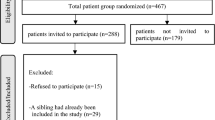Abstract.
Introduction:
Assessment of the effectiveness of clinical practice requires appropriate outcome measures.Health of the Nation Outcome Scales for Children and Adolescents (HoNOSCA) is a recently developed measure of outcome for use in child and adolescent mental health services (CAMHS). The aims of the present study were to evaluate sensitivity to change, face validity and clinical feasibility of HoNOSCA in a Danish field trial.
Method:
A prospective design in which HoNOSCA, Global Assessment of Psychosocial Disability (GAPD) and a clinician rated global outcome measure were completed at 15 field sites. 173 patients were rated both at initial assessment and at follow-up after three months.
Results:
HoNOSCA demonstrated satisfactory face validity. There was a strong correlation between HoNOSCA scores and GAPD scores (r = 0.6, P < 0.001) and a highly significant association (ANOVA (F = 25.4, P < 0.001)) between change in HoNOSCA scores and global clinical ratings of change.Mean HoNOSCA scores varied between psychiatric diagnoses.
Conclusions:
HoNOSCA is a sensitive and valid measure of change for children and adolescents attending CAMHS.
Similar content being viewed by others
Author information
Authors and Affiliations
Corresponding author
Rights and permissions
About this article
Cite this article
Bilenberg, N. Health of the Nation Outcome Scales for Children and Adolescents (HoNOSCA). European Child & Adolescent Psychiatry 12, 298–302 (2003). https://doi.org/10.1007/s00787-003-0343-1
Accepted:
Issue Date:
DOI: https://doi.org/10.1007/s00787-003-0343-1




